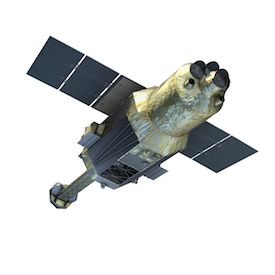Summary
|
Note: Hitomi (formerly ASTRO-H) was a high-energy astrophysics space observatory, developed by the Japan Aerospace Exploration Agency (JAXA) in collaboration with institutions in Japan, the US, Canada, and Europe. It carried four instruments that together spanned the energy range 0.3-600 keV. The science goals of this mission included studying the dynamics of hot gas in galaxy clusters, the accretion of matter onto supermassive black holes at the cores of distant galaxies, and the acceleration of cosmic-ray particles up to very high energies. The mission was launched on 17 February 2016 at 08:45 UTC. On 28 April 2016, JAXA announced that they would discontinue operations of Hitomi as it was no longer possible to communicate with the satellite following an anomaly which appeared to have resulted in both solar array paddles having broken off from the spacecraft body. In June 2017, ESA announced that it will participate in Japan's X-ray Astronomy Recovery Mission (XARM), designed to recover the science of the Hitomi mission. |
 |
| Artist's impression of Hitomi. Credit: JAXA |
The Hitomi satellite (known as ASTRO-H prior to launch) is an international X-ray observatory, extending also to soft gamma ray energies, developed by the Japan Aerospace Exploration Agency (JAXA) in collaboration with institutions in Japan, the US, Canada, and Europe. It is the sixth in JAXA's series of successful X-ray space observatories.
With its unprecedented combination of high energy resolution with broad energy coverage, ranging between 0.3 keV and 600 keV, Hitomi will greatly improve our knowledge about some of the most powerful phenomena in the Universe.
The core science goals of Hitomi concern: galaxy clusters, huge assemblies of galaxies containing large amounts of hot gas and even larger amounts of dark matter; supermassive black holes located at the centre of distant galaxies and actively devouring the surrounding matter; and cosmic rays, highly energetic particles that are accelerated in a variety of exotic locations in the Universe.
In galaxy clusters, Hitomi will reveal the abundance of elements present in the gas in which the galaxies are embedded and the gas velocity with greater accuracy than ever obtained so far. This will allow scientists to investigate the temporal evolution of these huge structures and to test current assumptions about the dynamical state of the gas within them.
With its novel spectroscopy concept, the observatory will also provide scientists with the opportunity to study, with unprecedented accuracy, how gas flows towards supermassive black holes and away from them. The broad energy coverage will contribute to unveiling in particular the population of black holes that are heavily obscured by gas and dust in the host galaxy.
Using Hitomi, scientists will also be able to identify and characterise the sites where cosmic rays are accelerated, observing them over a wide range of energies. These cosmic environments range from small-scale, local objects such as the remnants of supernova explosions, to gigantic, distant structures like galaxy clusters.
Hitomi carries four telescopes, two Soft X-ray Telescopes (SXT), with a focal length of 5.6 m each and covering the energy band 0.3-12 keV, and two Hard X-ray Telescopes (HXT), with a focal length of 12 m each and covering the energy band 5-80 keV. All four are grazing-incidence telescopes consisting of hundreds of concentric, nested conical shells coated in reflecting material to create a large collecting area for X-ray photons.
The light focussed by these four telescopes is detected by the three X-ray instruments on board: the Soft X-ray Imager (SXI), receiving light from one of the two Soft X-ray Telescopes; the Soft X-ray Spectrometer (SXS), receiving light from the other Soft X-ray Telescope; and the Hard X-ray Imager (HXI), with two detectors that receive light from the two Hard X-ray Telescopes.
In addition, the observatory carries the Soft Gamma-ray Detector (SGD), a non-focussing device to track higher energy photons, between 40 keV and 600 keV, that is also sensitive to polarisation.
Hitomi has been built by a major international collaboration led by JAXA with over 70 contributing institutions in Japan, the US, Canada, and Europe. In addition to ESA, the international members include NASA/Goddard Space Flight Center, Stanford University, The Netherlands Institute for Space Research (SRON), the University of Geneva, CEA Saclay, the AstroParticle and Cosmology laboratory (APC) at Paris Diderot University – Paris 7, and the Canadian Space Agency (CSA).
